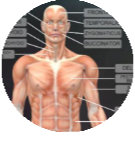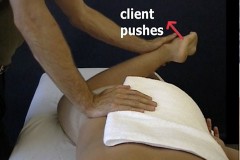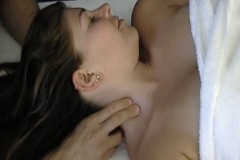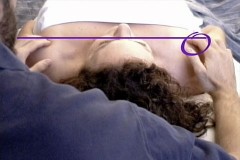This class covers the whole body, everything that is covered in the two Deep Tissue and NMT videos. Get a 3-dimensional view of the muscles, which have been modeled out of clay and feature computer generated trigger point referral overlays. These online videos not only cover neuromuscular therapy, but includes functional assessment work, so you know where to work, and how. Along with range of motion and resistive tests, you will learn basic postural evaluation techniques. As part of a comprehensive deep tissue treatment protocol, discover how to work on the tendons, ligaments and muscles with effective neuromuscular and deep tissue strokes. Finally complete the work with stretches.
This class also includes access to our 3d anatomy viewer which allows you to rotate the body and view 120 muscles and 100 bones detailed info on each.
MASSAGE MAGAZINE says: “To Riehl’s credit, his knowledge of the subject matter is evident & he makes some of the concepts, like pelvic torsion & subsequent compensations, useful even for advanced therapists. All viewers will gain insight into the nature of myofascial pain in the torso and extremities, and effective treatments… Giving clear instructions and explanations, Riehl encourages intuition while competently and carefully teaching the mechanics of this powerful treatment approach.”
DETAILED CONTENTS:
The hips, back and neck sections include 53 deep tissue massage techniques, 31 muscles and 29 trigger points. In these video lessons Mr. Riehl shows the assessment of the hips in terms of anterior/posterior rotation and high/low hip movements, and how these movement affect the lower back pain. Also covered are the adductors (for groin pulls), and the other hip muscles that control the internal and external rotation of the femur (like the piriformis that can cause sciatic nerve impingement). The lower back section discusses the most important muscles of lower back pain and their referral patterns, as well as how to evaluate for spinal mobility to help pinpoint pain. The neck section shows evaluation of the four ranges of motion and how to alleviate restriction. How to work on the anterior cervical vertebrae by pushing aside the trachea and touching the front of the cervical spine is also shown- great for whiplash sufferers. The deep tissue massage work on the scalenes will help people who have arm pain that comes from this area.
The shoulder, elbow, wrist, knee and ankle section covers 47 techniques, 30 muscles and 22 trigger points. These videos deal with sprained ankles, Achilles’ tendonitis, knee evaluation, anterior and posterior cruciate ligament strain, and anterior and posterior knee pain. Then the instructor shows a rotator cuff evaluation (both resisted testing and range of motion tests), muscle and tendon work on the rotator cuff muscles, evaluation and treatment of tennis and golfers elbow. The forearm section covers the evaluation and treatment of the finger, thumb and wrist muscles, including causes of carpal tunnel syndrome and ligament strain vs. muscle/tendon injuries. This video takes the complicated subject of the forearm and makes it understandable. With these techniques shown in this video, you should be well equipped to assess and perform quality work on any of these joints.
DEEP TISSUE MASSAGE INSTRUCTOR:
Sean Riehl has taught massage nationally, presented at the AMTA California conference, written multiple articles appearing in Massage Magazine and the Biotone Newsletter as well as being the author of a number of videos on massage.
Lessons
Anatomy Viewer for Deep Tissue

Introduction to Deep Tissue Massage and Neuromuscular Therapy

Discusses the basics of deep tissue massage and information about trigger points and referral patterns. Download the 75 page online manual in this lesson.
The hips

This lesson shows how to work and test the internal and external rotators, as well as the flexors, extensors and adductor groups. Trigger points and referral patterns are discussed.
The Back

How to work on back pain, including working the QL, longissimus, multifidus, iliocostalis, plus how to friction the iliolumbar ligaments and release the psoas, iliacus and rectus abdomens, and more!
The Neck

This lesson shows how to evaluate for rotation and lateral flexion, and how to work the muscles that limit these motions.
The shoulder

Shows how to evaluate the shoulder in 3 directions, how to release all the muscles that control the shoulder, as well as the trigger points and referral patterns.
The elbow

How to help tennis elbow, golfer’s elbow and release the muscles that control extension and flexion of the elbow joint.
The Wrist

Learn how to evaluate the flexors and extensors of the thumb, fingers and wrist. Perform massage techniques to release all these muscles, and address carpal tunnel syndrome.
The knee

Shows how to evaluate the knee, and work the muscles that control flexion and extension. Also shows how to evaluate the medial and lateral collateral ligaments, and how to cross fiber friction these ligaments plus the coronary ligament, and around the patella.
The ankle

Show how to work muscles that control the ankle, and friction the ligaments the stabilize the ankle.

Follow Us!